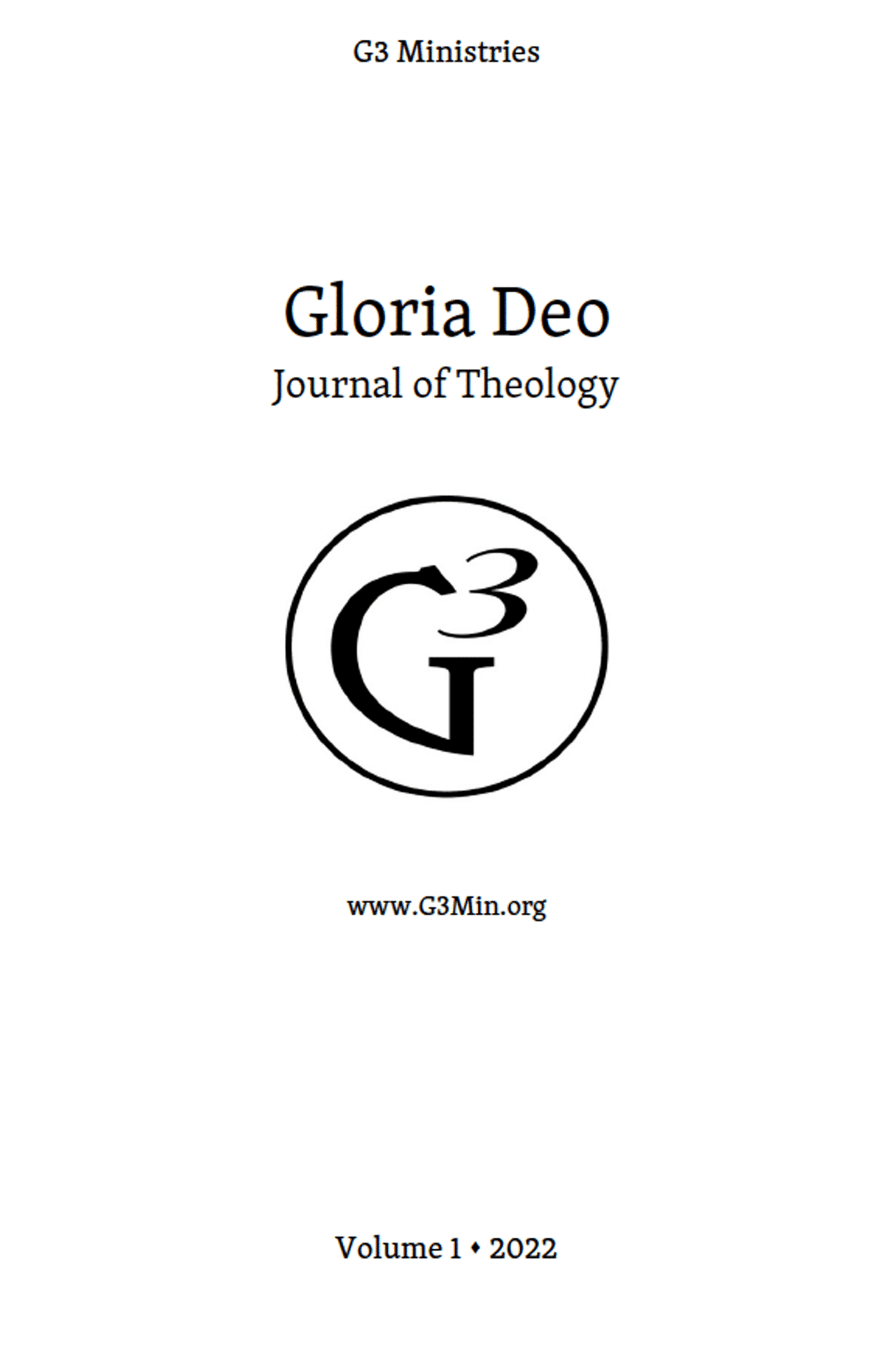Gloria Deo Journal of Theology is an evangelical theological journal published annually at www.G3Min.org by G3 Ministries. It focuses on biblical, theological, and historical topics for pastors.
Publisher: Josh Buice
Editor-in-Chief: Scott Aniol | [email protected]
Editorial Committee: Chip Thornton, Owen Strachan, Mike Riccardi
Editorial Assistants: Laramie Minga, Lyndsey Huckaby
Volume 1 (2022)
The Unity of the Godhead: The Chief Cornerstone of Definite Atonement
Steven Lawson
The atoning death of Jesus Christ stands at the very heart of the gospel message. Christ and him crucified is the centerpiece of the Christian faith. His sovereign lordship and saving work are the alpha and omega of what we believe and proclaim. Solus Christus—Latin for Christ alone—is the power of God unto salvation and the wisdom of God unto eternal life. Jesus is the only Savior of the world, the sole Redeemer of those held in the bondage of their sins. He is the only hope for rebels against the rule of God to have a right standing before him and the only basis for admission into heaven. In short, there is no other hope for the sinner to find acceptance with God except in Jesus Christ.
Plain Speech on Church Discipline
Chip Thornton
One of the biblical marks of a true church is the proper practice of church discipline. However, few American evangelical congregations practice it.
A new generation of pastors now is emerging—a generation who wasn’t there when the resurgence of congregational discipline took place. If they’ve witnessed it at all, it’s often done wrongly. In my conversations with younger pastors, they seem to be asking three questions: (1) When do you do it?; (2) How do you do it?; and (3) Why do you do it? We can’t tackle every issue related to congregational discipline here. What we can do is acquaint a fresh generation of pastors as to its pervasive importance to a congregation’s overall health. To do so, I’ve organized my thoughts this way: (1) a deep, exegetical dive into Matthew 18:15–20; (2) biblical guardrails for defining disciplinable offenses; and (3) implications pastors must consider as they execute congregational discipline.
Biblical Ordinances and Visible Signs: How Baptists Weakened Biblical Authority by Limiting Ordinances to Two
Scott Aniol
Modern Baptists frequently claim that a key Baptists distinctive is the conviction that the church has been given only two ordinances—baptism and the Lord’s Supper. For example, The Baptist Faith and Message (2000), the confessional statement of the Southern Baptist Convention, describes a New Testament Church as a “congregation of baptized believers” that, among other things, observes “the two ordinances of Christ,” and the GARBC website similarly states, “The local church should practice two ordinances: (1) baptism of believers by immersion in water . . . and (2) the Lord’s Supper, or communion.”
Yet this paper will demonstrate that limiting church ordinances to two has not always been the case for Baptists. Instead, I will show that Baptists only recently began using this language, adopting the term ordinance to replace the term sacrament in describing baptism and the Lord’s Supper. I will first demonstrate that seventeenth- and eighteenth-century Baptists listed more than only two ordinances for the church, followed by an exploration of their use of the term “sacrament” to distinguish baptism and the Supper from the other ordinances. I will then identify when and why language among Baptists changed to limit the ordinances to two and argue that this change weakened biblical authority among modern Baptists.
The Rise and Fall of Keach’s Catechism: Evidence of an Underdeveloped Baptist Theology of Children
Corey Johnson
How does the Baptist tradition view believers’ children? Historically, Baptists have axiomatically rejected infant church membership and infant baptism, yet this level of consensus does not exist regarding a positive understanding of believers’ children. Baptist literature is teeming with thorough considerations of believers’ children in terms of who they are not (they are not the proper recipients of baptism or church membership by birth), but the same thorough consideration has not been given to believers’ children in terms of who they are.
Scholarly work related to practical considerations such as baptismal and conversion age does exist, but there is little to no work regarding the fundamental nature of the child. The aim of this paper, however, is not to address these fundamental questions but rather to draw awareness to the need for Baptists to address such questions pertaining to the relationship between believers’ children and the church. This objective will be achieved by surveying the historical changes that occurred in Baptist children’s’ instruction. During the seventeenth, eighteenth, and nineteenth centuries, catechetical instruction of children was prevalent among Baptists, but this once-common practice was almost completely abandoned when the twentieth century experienced a shift from catechetical instruction to the evangelistic emphasis of Sunday school. This transformation was not necessarily caused because Baptists failed to address the fundamental nature of believers’ children, but it ought to give us pause and lead historians and theologians to ask whether this transformation was the result of theological development, the outcome of pragmatism, or the outworking of Baptists spending too little time considering and articulating the fundamental nature of believers’ children. Regardless, the need remains for Baptists to consider the relationship between believers’ children and the church. In order to bring awareness to this need within Baptist theology, this paper will survey Benjamin Keach’s influence upon catechetical instruction until the nineteenth century and will then present the shifts that occurred in the twentieth century, both in the method used to instruct children within Baptist churches as well as in the party primarily responsible for children’s training and instruction.
Radical Grace
Jon Pratt
In recent years three streams of antinomian teaching have come to light, and they flow out of three different models of sanctification teaching. But before delineating these streams, I must take a brief foray into the world of sanctification models.
The current antinomian river flowing through American evangelicalism can trace its origins to three tributaries, each of which comes out of a different model of sanctification instruction. The first stream, based in the Chaferian model, is Free Grace theology. Second, Pentecostalism has given birth to hyper-grace teaching. Third, the Reformed model has produced a difficult-to-label group of antinomians. It is this third stream that I would like to introduce and evaluate in this essay.
To reiterate, these three streams of antinomian teaching have precipitated a perilous slipping away from the New Testament’s demands for obedience in the life of the Christian. And the third stream is particularly insidious which is why I am warning the reader to avoid this “irreverent babble, for it will lead people into more and more ungodliness” (2 Tim 2:16). I shall proceed by considering first the naming of this Reformed-based grace teaching. Second, I will move from naming to the history of this teaching. Third, I will advance from history to the doctrinal teaching itself. Finally, I will compare this doctrinal teaching with the concept of perseverance and tease out some implications.
Catholicity and Intergenerational Worship
Terry L. Johnson
Historic Reformed Protestantism takes seriously the history and doctrine of the church. It honors the church local and universal, visible and invisible. It esteems the historic form of public ministry. It values catholicity. It respects the “communion of the saints,” past, present, and future. Decisions regarding worship practices typically have not been made in isolation from other churches or from the Christian tradition of worship. Adaptations normally have not been made quickly or idiosyncratically, but have been gradual, and made in consultation with the whole church across the ages. Those who are interested in liberating the church from unwarranted cultural influences should be particularly interested in historic Reformed ministry and worship. Traditional Reformed Protestantism resists the incursions of western pop-culture with its hyper-individualism, rootlessness, love of novelty, superficiality, and the cult of youth that have been so prominent in the shaping of contemporary worship.
What I hope to show in the following pages is that the principle of catholicity requires that we establish a single universal or common public service, that the principle of the communion of the saints requires that such a service gather together all the saints without regard for race, ethnicity, sex, culture, and especially for our purposes, age and generational differences. These, I hope to show, are the principles of the apostles, and should remain the ideals for us today.
Book Reviews
Hamilton, James. M. Psalms (S. Aniol)
Lau, Te-Li. Defending Shame: Its Formative Power in Paul’s Letters (J. Moore)
Reeves, Michael. Rejoice and Tremble: The Surprising Good News of the Fear of the Lord (D. de Bruyn)
Rhodes, Matt. No Shortcut to Success: A Manifesto for Modern Missions (R. Bush)




